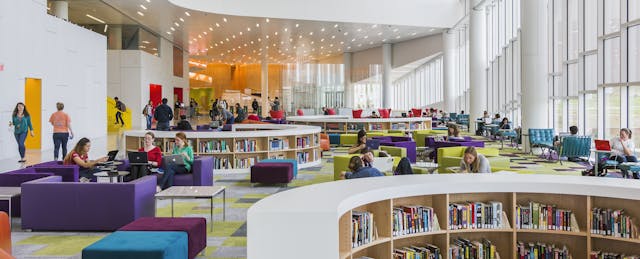Today’s college students are spending more time than ever in public and campus libraries. According to a recent Pew Research Report, millennials are most likely to have visited a public library in the past year compared to any other generation.
But what would make a generation that grew up with internet so reliant on libraries—spaces traditionally known to be filled with shelves upon shelves of books?
The answer, in part, lies in the so-called maker movement, a trend studded by hobbyists, inventors, students and even entrepreneurs who creates products or gadgets for educational or industrial purposes. The grassroots community has garnered much attention in K-12 spaces, but many of today’s college students also exude a mindset that emphasizes practice over theory. In a report that analyzed the state of the maker movement in 40 U.S. universities, the Makeschools Higher Education Alliance identified student engagement in projects that transcend traditional learning to be a flagship quality of the emerging maker movement on campus.
Now, tapping into their student population’s “maker” spirit, campuses are investing in new spaces, curricula and partnerships to transform libraries into new-age spaces for exploration and invention. The University of California, San Diego, for example, is in the midst of redeveloping its Geisel Library, which opened in 1972. The university wrote: “no one could have foreseen how radically the digital revolution would change how information is found and used. As the Library’s collections shift from print to digital, spaces once used for books and journals are increasingly needed to accommodate the various approaches to study, research, and learning of today’s students and scholars.”
Across the country at North Carolina State, the Hunt Library is the university’s “library of the future.” In addition to a collection of print books (which can be delivered via robot), the library features spaces including a creativity studio, a gaming lab, study rooms, recording studios, and yes, a makerspace.
Whether it’s labeled a multimedia lab, a student resource center or a makerspace, the idea of the modern library is now more dynamic than ever. These spaces have the capability to serve students from all academic disciplines in project creation. Students are no longer limited to resources available within their own academic departments.
Here are a few essential elements to develop the campus library that fits your students’ needs:
Determine student need and identify goals
A new makerspace on campus should start with student opinion. Survey the entire student population to understand what projects they’re already exploring independently, characteristics of their favorite working spaces, and more. These responses will clue your administration team into what needs exist for your unique student population, and will help you answer questions from stakeholders like, “how will students actually use it?”
Involving the student body will also fuel a new mentality, one that welcomes students of all backgrounds to create, innovate, and even fail. After all, “empowerment isn’t something you DO to people, it’s something that happens when people do powerful things that matter to them,” said Susan Klimczak, of FabLearn Fellows, a project of the Stanford Transformative Learning Technologies Lab.
Students will help your team identify top goals for your space, such as increased student agency and engagement, consolidation of campus resources or community involvement.
Measure space design
Physical space design on college campuses is beginning to model modern social and work environments. And a versatile space where students feel welcome to hang out, collaborate and be creative is critical to a library revamp.
Factors like space layout, furnishing, environmental friendliness and technology will provide the framework needed to facilitate modern learning experiences. But space design is sometimes more abstract; factors like alignment with campus academic strategy support and training should be considered as well.
These variables will help your team strike harmony across different teaching and learning styles, while supporting the school’s overall mission. And to measure a modern library’s space design, EDUCAUSE provides a rubric to help “institutions to benchmark their environments against best practices.”
Pulse-check and promote
It’s possible that concepts for your ideal space may already exist in hidden corners of campus, however they might be hidden within subsets of academic departments. For example, the engineering department may have a makerspace available to students within a specific course, or those who hold a certification to operate certain machinery/lab equipment.
That was the case for the University of Illinois at Chicago College of Engineering, which created a makerspace for students in enrolled in a course on 3D printing. The college identified a problem with the exclusivity of the space though: not enough students knew about it or were using it. To increase participation, engineering professors began to take their classes on a guided tour of the makerspace each semester.
Visiting labs and libraries outside of your own department with the goal of understanding—and perhaps collaborating with—other makerspaces may break down department silos and help increase use by the general student population.
Cut through edtech market noise by crowd-sourcing
Concept? Check. Space? Check. Tools? Here we embrace the trials and tribulations of purchasing. Purchasing in higher education continues to fragment into different subsets of influencers in an increasingly “noisy” marketplace. Distill your decision-making process by taking the following tips into consideration:
Reference what your students want to get out of their new and improved space, and think critically about what tools will help them achieve those goals. It can be easy to get bogged down when considering highly technical specifications.
Assemble a team of three to five decision-makers from different positions on campus to go in on purchasing together and develop plans to increase returns on investment. In addition to gaining buy-in from your campus chief information officer, you may consider consulting your campus computer department, or even your art department.
Look off-campus for recommendations. Identify contacts you’ve met at conferences or events to get product opinion from the end user. You may even consider crowd-sourcing product opinion in higher education Twitter chats, like the #HElivechat or #HigherEdChat.


